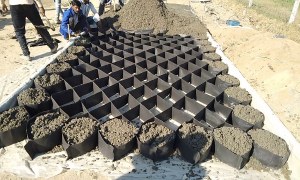🕑 Reading time: 1 minute
Several types of cracks occur in masonry walls in a building which can be minor and insignificant, some requiring expensive repairs and in some extreme cases the only solution is total demolition of the wall. Causes of these cracks in masonry walls can be movement of building causing settlement and subsidence.Contents:
Common Causes of Cracks in Masonry Walls
Settlement and subsidence of building walls is shown in figure below.
Fig.1: Settlement and Subsidence of Masonry Wall

Fig.2: Cracks in Masonry Walls
Types of Cracks in Masonry Walls and Causes
1. Expansion Cracks in Masonry Wall
Causes of Expansive Cracks
Walls are affected by temperature and moisture change. Materials can suffer from initial shrinkage and/or subsequent expansion and contraction. This movement gives rise to the expansion cracks in masonry walls. The crack shown in the picture is shown as vertical, which is often the case. However, the crack sometimes follows the line of least resistance and can end up stepped.
Fig.3: Expansion Cracks in Masonry Wall
Repair of Expansive Cracks
Expansive crack is of no real structural significance, although it may allow water into the cavity in brick built houses, and subsequence cause deterioration of the wall ties. Therefore filling the crack with a mastic or sealastic compound is recommended. However, for more severe cracking it is advisable to form an expansion joint. This would be cut into the wall, filled with a compressible material with a waterproof stopper to the outside. On some modern buildings these are formed at construction stage and then hidden behind rainwater downpipes.2. Cracks Above Openings in Masonry Walls
Causes
Four causes of cracks above openings in masonry walls are:- Removal of windows or doors with inadequate propping,
- Inadequate bearings,
- Loads applied directly over the opening,
- No lintels.
Cause-1: Removal of windows or doors with inadequate propping
The most common reason for this type of cracks in wall is the removal of existing window frames to install PVCu.Repair of Cracks
The best repair is to reset the lintel and repoint or rebuild the brickwork above, and refit the window. The poor repair is to do nothing more than repoint the cracks, as the brickwork is now resting on the new frame. However, collapse of the brickwork above the opening will be likely when the window is next replaced.Cause-2: Cracks due to Inadequate Bearings
The correct overhang (bearing) of the lintels above openings is 150mm (6 inches) each side. If the bearings are insufficient the lintel will drop and the cracks will appear.Repair of Cracks due to Inadequate Bearing
Replacement of the lintel is recommended. However, once again repointing will suffice until the window or door is replaced.Cause-3:Cracks due to loads applied above the opening
This often occurs above first floor lintels where the roof purlins have been installed directly above the window openings. The load imposed is too great for the lintel to cope with and the downward pressure causes the cracking.Repair
Once again replacement of the lintel is recommended. The severity and age of these cracks would decide whether simple repointing would suffice until the window is replaced.Cause-4: Cracks in Masonry Wall due to No Lintels
In some properties no lintels are provided relying on the timber frame of the window to support the masonry above, but once the window is replaced the cracks occur.Repair
New lintels need to be installed and the cracks repaired.3. Cracks in Masonry Wall due to Tie Failure
Wall ties are metal ties that are built into both solid and cavity walls built in stretcher bond to hold the outside skin of brickwork to the inside. Failure normally occurs when the ties rust. When the metal ties rust they expand causing the cracking normally seen every sixth course horizontally in the mortar joints.Repair
Replacement wall ties are essential. The cracking is an early indication of failure. Without replacement, collapse of the wall could occur. Repointing and removal of the existing ties is recommended.4. Cracks in Masonry Wall due to Subsidence
This is the worst and most serious type of cracks in masonry walls and consequently the most difficult to repair. Subsidence can occur due to a variety of reasons:- Mining activity
- Leaking underground drainage
- Tree root activity
- Peak subsoil
- Clay subsoil
- Running sand


